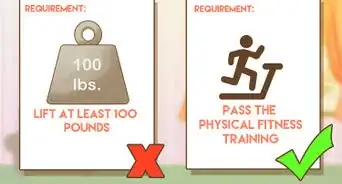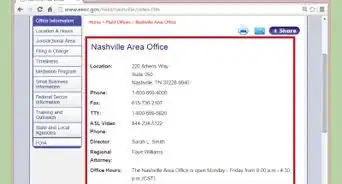This article was written by James Fett and by wikiHow staff writer, Jennifer Mueller, JD. James Fett is a Lawyer based in Ann Arbor, Michigan. With over 35 years of experience, he specializes in alternative dispute resolution, civil litigation, civil rights, class actions, commercial litigation, employment litigation, and labor & employment. James earned a J.D. from The University of Michigan Law School as well as an MBA and BA from The University of Michigan. In 2001, he was awarded a Certificate of Special Congressional Recognition, and the Washtenaw Trial Lawyers Association named him Lawyer of the Year in 1996. He’s also been named a Michigan Super Lawyer by Law & Politics Magazine and one of the ten Most Outstanding Lawyers of the Year by Michigan Lawyers Weekly.
There are 13 references cited in this article, which can be found at the bottom of the page.
This article has been viewed 29,479 times.
There are numerous state and federal laws that prohibit discrimination in a variety of different contexts. These laws may forbid discrimination against people on the basis of race, ethnicity or national origin, gender, sexual orientation, religion, and other traits or characteristics that were with you from birth. To file a discrimination lawsuit for violation of these anti-discrimination laws, you typically must first file a complaint or charge with the state or federal agency that enforces the law. If that doesn't resolve the dispute, you'll want to hire an attorney before pursuing your cause in state or federal court.[1] [2]
Steps
Exhausting Administrative Remedies
-
1Organize your evidence and documentation. Before you file a complaint or charge with an administrative agency, you should gather all documents and information you have that supports your claim so you can fill out the required forms completely and accurately.[3] [4]
- Proving discrimination often can be extremely difficult, because it's rare that anyone engaging in discrimination will leave a paper trail.
- You'll want to gather any documentation you have though, including any written communication you've had with the person you believe discriminated against you.
- You also should gather any other documents or information related to your claim. For example, if you're making a discrimination claim against your employer, you'll need information about your employer and your workplace as well as details of your employment.
- If you're suing a landlord for housing discrimination, relevant information would include a copy of the listing of an available apartment, or notice of a rate increase.
- The best way to document discrimination is to keep a journal of all the incidents. Try to record these incidents right after they happen—each entry should be as detailed as possible (with the date included), and should mention what occurred and any persons present during the incident.
-
2Provide notice. In some contexts, such as if you are filing a discrimination charge against your employer with the federal Equal Employment Opportunity Commission (EEOC), you must first provide them with notice of your intent so they have an opportunity to resolve the dispute before you involve state or federal authorities.[5] [6]
- Generally, both administrative agencies and state and federal courts have a strong preference for making an attempt to resolve the dispute privately before getting the government involved.
- For this reason, even if you aren't required to attempt a private resolution before you call in government intervention, it's generally a good idea to make your complaints known and try to find a mutually acceptable settlement.
- To provide notice, send a written letter to the individual or business you intend to charge with discrimination. Outline the facts of your dispute and your desired outcome.
- Give the individual or business a deadline to respond to your letter, and mail it using certified mail with returned receipt requested, so you know when it was received.
- Before you mail your signed letter, make a copy of it for your own records. When you get back the green card from the postal service letting you know the letter was received, file it with your copy of the letter.
- If the agency with which you're filing your complaint or charge requires you to first notify the individual or business you're accusing of discrimination, your copy of the signed letter and your certified receipt will serve as proof that you've fulfilled this requirement.
Advertisement -
3Assess your eligibility. Each agency has its own requirements regarding the individuals and the types of discrimination covered by the state or federal laws it enforces. A visit to the agency's website typically will give you the information you need to determine your eligibility.[7] [8] [9]
- There are federal laws that prohibit discrimination and are enforced by federal executive agencies such as the Department of Labor (DOL) or the Department of Housing and Urban Development (HUD).
- Each state also has its own anti-discrimination laws that are enforced by state agencies. These laws often cover more individuals and businesses, and may apply in more contexts than the federal laws do.
- Particularly in the employment context, you may have the ability to dual-file your charge, which means you can file a charge with the state agency and the state agency will file it for you with the appropriate federal agency.
- The EEOC has an online assessment system you can use to quickly and easily assess your eligibility by answering a few questions. Other agencies may have similar tools available on their websites.
- You also can determine your eligibility by calling or visiting a local office and speaking to an agent there. Agency employees are trained to assess eligibility and will be able to answer your questions.
-
4Complete the required forms. The agency typically has a specific form that you must fill out to file a complaint or charge of discrimination. You may be able to download a copy of the form from the agency's website, or pick up a paper copy at a local field office.[10] [11]
- You must enter information about yourself, including contact information, as well as information about the individual or business you are charging with discrimination.
- Generally, you'll need to have names and addresses. If you are charging a business with discrimination, you may need the name of the business owner or responsible party as well as the names and positions of any specific individuals who discriminated against you.
- You also must provide a chronological summary of the dispute that occurred, including the actions that you believe constitute discrimination.
- Stick to the facts in your summary, and include as many details as you can, including the date, time, and location of any incident you describe.
- Typically you have the ability to attach any documentation that you have. If there's no way to attach documents to the form, simply note that you have them and can make them available to the agent who evaluates your complaint or charge.
- Once you've finished the form, make a copy of it for your own records before you submit it to the agency. Check the agency's website or call the local field office to find out how you need to submit your form.
- You may be able to fill out and submit a form online, or you may have to print it out and mail it or take it in person to the local field office.
- Some agencies give you the ability to file a charge over the phone, but the agency will send you a written copy of your charge which you must file before your charge will be evaluated.
-
5Cooperate with the agency investigation. Typically, your complaint or charge will be assigned to a particular agent, who will review it and conduct an investigation of the situation. Over the course of this investigation, you may be interviewed if the agent wants further information from you about the discrimination you've experienced.[12]
- Typically the agent assigned to your complaint or charge will contact you once they've had a chance to read it over. They'll have questions for you, which you should answer as completely and honestly as you can.
- If an agent asks you a question to which you don't know the answer, you should simply say "I don't know." Don't try to guess or make something up.
- The agent will talk to the people listed in your complaint or charge who you allege discriminated against you. They'll have an opportunity to explain their actions, and based on their explanations the agent may have additional questions for you.
- Keep in touch with the agent assigned to your case for updates on the status of the investigation. You may be asked to participate in mediation or other negotiations to resolve the dispute.
-
6Receive a right-to-sue notice. If you were required to exhaust all administrative remedies before filing a lawsuit, the agency will send you a right-to-sue notice when the investigation is complete – typically if no violation was found or if the agency chose not to act.[13] [14]
- In some situations, you may be able to file a lawsuit even before the agency has completed its investigation. Ask the agent assigned to your case, or talk to a licensed discrimination attorney to find out for sure.
- If you're required to wait until the investigation is concluded, you should wait to take any other action until you receive that notice in the mail. You cannot file a lawsuit without providing the court a copy of that notice, or your lawsuit will be summarily dismissed.
- Keep in mind that until you receive your right-to-sue notice, there's still a chance the agency will resolve the situation for you, or that the Department of Justice will elect to sue on your behalf, in which case you won't have to worry about the time, effort, and expense involved in filing your own private lawsuit.
Hiring an Attorney
-
1Search for possible attorneys. You can begin your search on the website of your state or local bar association. Typically there will be a searchable directory of lawyers who are licensed to practice in your area.[15]
- You want an attorney who has experience representing plaintiffs in discrimination lawsuits – particularly the type of discrimination you've suffered.
- For example, if your boss is discriminating against you at work by not considering you for a promotion because you are a woman, you want to look for attorneys who have experience with employment discrimination on the basis of gender.
- Keep in mind also that the standards and procedures differ between federal court and state court. Your attorney ultimately will decide which court would be best for your lawsuit, so you should focus on attorneys who have experience with both federal and state law.
- Once you have a list of possible attorneys, visit their websites or search for them on the internet to find out more about each one. This research should enable you to narrow the list down to a handful of attorneys you want to meet in person.
- Look for attorneys who have experience practicing in both federal and state court and are familiar with both state and federal laws.
-
2Interview at least three candidates. Since most attorneys provide a free initial consultation, you should talk to several attorneys before you make your final decision who to hire, so you can be more confident that you're making the best choice.[16] [17]
- Before your first meeting, draft a list of questions that you want to ask each attorney. You want to ask questions about their experience, as well as the outcomes of past cases and their style of practice.
- Find out how much of the work will be done by the attorney and how much will be done by other associates or paralegals. If there are other people on the attorney's team who will be doing a lot of the work on your case, ask if you can meet them as well.
- If the attorney has a form or other information they want from you before the initial consultation, make sure you get this information together for them as soon as possible so they have time to adequately prepare for the initial consultation.
- For the first part of the interview, let the attorney do most of the talking, but keep in mind that typically this is more a sales pitch than anything else, especially if the initial consultation is free.
- Even if the attorney seems to have answered one of the questions you have on your list, ask anyway – you may get a different or more detailed answer than what the attorney provided in their presentation.
- See if the attorneys have any trial experience. Employment discrimination cases may come down to whether a jury believes the reason for the adverse action (e.g., termination, demotion, etc.) was discrimination, and these can often be circumstantial cases. Having an attorney with trial experience will not only benefit you at trial but may make the employer more likely to settle the case beforehand.
-
3Compare and contrast the attorneys you interviewed. After you've interviewed several attorneys, make a list of particular qualities such as experience and knowledgeability to evaluate and rank the possible attorneys.[18]
- Many discrimination attorneys work on a contingency fee agreement, meaning the attorney takes their fees out of any settlement or award you win, and won't get paid otherwise.While fees may be important to you, particularly if you have tight finances, they shouldn't be the only factor you consider.
- If you go with one attorneys over the others simply because they charge the lowest fees, it may be essentially throwing money away if that attorney is unable to represent you effectively.
- How you get along with an attorney may be just as important as their expertise and their track record. If the attorney made you feel uncomfortable or intimidated during the initial consultation, you may have difficulty working with them, especially in discussing the sensitive information involved in a discrimination lawsuit.
-
4Sign a written retainer agreement. When you've made your final decision, meet with your chosen attorney and go over the terms of the representation. Even if the attorney has agreed to represent you on contingency, you still want to make sure you sign a written agreement before they begin any work on your behalf.[19]
- The retainer agreement will outline specific things the attorney will bill you for, and detail how these expenses will be accounted and charged.
- If you've paid a retainer, the agreement will break down how that amount will be spent and when you can expect another bill for the attorney's services.
- Attorneys who aren't working on contingency should be able to give you a general estimate of how much total fees and costs will be for your case. They may even give you several estimates based on the occurrence of various contingencies.
- Make sure you understand everything in the retainer agreement before you sign, and don't be afraid to ask any questions.
- You also shouldn't be afraid to negotiate. The retainer agreement the attorney presents to you is an opening offer – even if they present it otherwise. If there's something you don't like, bring it up and see what kind of deal you can work out.
Starting Litigation
-
1Meet with your attorney. Before a complaint is filed, your attorney typically will want to meet with you at least once, if not several times, to go over the discrimination you've experienced and the actions you've taken since that experience occurred.[20] [21]
- Based on the type of discrimination you've experienced and the identity of the individual or business responsible, your attorney will make a decision whether to sue in state or federal court.
- In some instances, state law may provide greater coverage for you, in which case your attorney typically will recommend suing in state, rather than federal, court.
- State court has other benefits for you as a litigant – chief among them, the process of filing a lawsuit is less expensive and less time-consuming. Additionally, state court procedures typically are less complex than those in federal court.
- Your attorney will draft a basic outline or litigation plan to give you a rough timeline of how the litigation will proceed and the various events that will take place over the course of litigation.
- Keep in mind that especially at this stage, any litigation plan is contingent on what happens with your lawsuit, and probably will change many times over the course of litigation.
-
2Draft your complaint. The complaint is the document that initiates your lawsuit in either state or federal court. The complaint identifies you and the individual or business that you claim discriminated against you, along with a list of factual allegations that constitute that discrimination.[22] [23]
- Your attorney can draft and file the complaint on your behalf.
- Your attorney will go over the complaint with you before it is filed. You should make sure that all the information in that document is true and accurate to the best of your knowledge.
- Assume that every allegation you make will be denied and challenged extensively by the party you're suing.
- If there's anything in your complaint that you don't understand, ask your attorney to explain it to you before it is filed.
-
3File your complaint. Once your complaint is completed, it must be filed with the clerk of the court that you want to hear your lawsuit. After your complaint is filed, it must be served on the individual or business that you're suing for discrimination.[24] [25]
- When your complaint is filed, you will have to pay a filing fee of several hundred dollars. Your attorney may bill you for this separately, or add it to their tab if they're working on contingency.
- Make sure you get a copy of your filed complaint for your records.
- To complete service of process, typically your attorney will hire a sheriff's deputy or private process server to hand-deliver the complaint, a summons, and other required court documents.
- The costs of serving your complaint also will be added to the court costs for your lawsuit.
-
4Wait for a response. Once the individual or business you're suing is served with your complaint, they have a brief period of time – typically a month or less – to file some sort of written response to your lawsuit.[26] [27]
- Any response filed by the other side also will be served on your attorney, who may simply send you a copy or have a meeting with you to go over the documents.
- Typically the other side will file an answer in which they deny the allegations you made in your complaint. They may include specific defenses or counterclaims against you.
- If the person or company you're suing responds to your complaint by filing a motion to dismiss, you'll have to attend a motion hearing before litigation proceeds.
- At the hearing on the motion to dismiss, you and your attorney must demonstrate to the court that there is a question of fact for the judge or jury to decide at trial.
- Only once all these initial court papers, or pleadings, are filed can pre-trial litigation begin in earnest.
-
5Begin the discovery process. Once all pleadings have been filed and any motion to dismiss has been dealt with, your litigation typically enters into the discovery phase. You and the other party will exchange information and documents that constitute potential evidence in the lawsuit.[28] [29] [30]
- Discovery typically consists of written discovery as well as depositions, which are interviews your attorney will conduct of the other party or of third-party witnesses.
- Written discovery consists of interrogatories and requests for admissions, which are questions sent to the other party. You also typically will make requests for production, which require the other party to send you copies of documents related to the allegations in your complaint.
- Due to the difficulty of proving discrimination, often your strongest evidence will be found through discovery.
- For example, suppose you are suing for housing discrimination based on race. You can get the defendant's records through a request for production. By evaluating these records, you could potentially show that the defendant has a record of denying black applicants, while approving similarly situated white applicants.
- In the same example, you also could use depositions to interview individuals who worked in the housing office of the landlord, to find out if they were told not to rent to black people, or if there were other discriminatory policies the landlord had that related to how applications were evaluated.
Expert Q&A
-
QuestionWhat are some signs of disability discrimination?
 James FettJames Fett is a Lawyer based in Ann Arbor, Michigan. With over 35 years of experience, he specializes in alternative dispute resolution, civil litigation, civil rights, class actions, commercial litigation, employment litigation, and labor & employment. James earned a J.D. from The University of Michigan Law School as well as an MBA and BA from The University of Michigan. In 2001, he was awarded a Certificate of Special Congressional Recognition, and the Washtenaw Trial Lawyers Association named him Lawyer of the Year in 1996. He’s also been named a Michigan Super Lawyer by Law & Politics Magazine and one of the ten Most Outstanding Lawyers of the Year by Michigan Lawyers Weekly.
James FettJames Fett is a Lawyer based in Ann Arbor, Michigan. With over 35 years of experience, he specializes in alternative dispute resolution, civil litigation, civil rights, class actions, commercial litigation, employment litigation, and labor & employment. James earned a J.D. from The University of Michigan Law School as well as an MBA and BA from The University of Michigan. In 2001, he was awarded a Certificate of Special Congressional Recognition, and the Washtenaw Trial Lawyers Association named him Lawyer of the Year in 1996. He’s also been named a Michigan Super Lawyer by Law & Politics Magazine and one of the ten Most Outstanding Lawyers of the Year by Michigan Lawyers Weekly.
Lawyer The most obvious sign is derogatory comments relating to your disability. Another major sign is the unequal treatment of the disabled employee compared to others. This can include hyper-scrutiny, compensation discrepancies, heaping excess amounts of work on the disabled employee, giving the disabled employee less opportunity, and relegating the disabled employee to less favorable tasks. Lastly, a refusal to accommodate a disability can be an indication of disability discrimination.
The most obvious sign is derogatory comments relating to your disability. Another major sign is the unequal treatment of the disabled employee compared to others. This can include hyper-scrutiny, compensation discrepancies, heaping excess amounts of work on the disabled employee, giving the disabled employee less opportunity, and relegating the disabled employee to less favorable tasks. Lastly, a refusal to accommodate a disability can be an indication of disability discrimination. -
QuestionHow do you prove discrimination in the workplace?
 James FettJames Fett is a Lawyer based in Ann Arbor, Michigan. With over 35 years of experience, he specializes in alternative dispute resolution, civil litigation, civil rights, class actions, commercial litigation, employment litigation, and labor & employment. James earned a J.D. from The University of Michigan Law School as well as an MBA and BA from The University of Michigan. In 2001, he was awarded a Certificate of Special Congressional Recognition, and the Washtenaw Trial Lawyers Association named him Lawyer of the Year in 1996. He’s also been named a Michigan Super Lawyer by Law & Politics Magazine and one of the ten Most Outstanding Lawyers of the Year by Michigan Lawyers Weekly.
James FettJames Fett is a Lawyer based in Ann Arbor, Michigan. With over 35 years of experience, he specializes in alternative dispute resolution, civil litigation, civil rights, class actions, commercial litigation, employment litigation, and labor & employment. James earned a J.D. from The University of Michigan Law School as well as an MBA and BA from The University of Michigan. In 2001, he was awarded a Certificate of Special Congressional Recognition, and the Washtenaw Trial Lawyers Association named him Lawyer of the Year in 1996. He’s also been named a Michigan Super Lawyer by Law & Politics Magazine and one of the ten Most Outstanding Lawyers of the Year by Michigan Lawyers Weekly.
Lawyer There are two methods—one is the direct evidence framework, which is a statement by a decisionmaker that your protected characteristic (e.g., race, sex, gender, etc.) was the reason for the adverse employment decision. The second method is the indirect evidence framework, which is when there is no direct evidence. The employee has to demonstrate "circumstances which give rise to an inference of discrimination." This can be demonstrated in a variety of ways, including unequal or disparate treatment, replacement by another employee outside of the employee's protected class, and more.
There are two methods—one is the direct evidence framework, which is a statement by a decisionmaker that your protected characteristic (e.g., race, sex, gender, etc.) was the reason for the adverse employment decision. The second method is the indirect evidence framework, which is when there is no direct evidence. The employee has to demonstrate "circumstances which give rise to an inference of discrimination." This can be demonstrated in a variety of ways, including unequal or disparate treatment, replacement by another employee outside of the employee's protected class, and more.
Expert Interview

Thanks for reading our article! If you'd like to learn more about filing a discrimination lawsuit, check out our in-depth interview with James Fett.
References
- ↑ https://www.justice.gov/crt/how-file-complaint
- ↑ http://civilrights.findlaw.com/enforcing-your-civil-rights/lawsuits-for-civil-rights-violations-and-discrimination.html
- ↑ http://www.nolo.com/legal-encyclopedia/suing-harassment-discrimination.html
- ↑ http://www.nolo.com/legal-encyclopedia/can-i-sue-landlord-housing-discrimination.html
- ↑ https://www.eeoc.gov/employees/charge.cfm
- ↑ http://www.nolo.com/legal-encyclopedia/suing-harassment-discrimination.html
- ↑ https://www.eeoc.gov/employees/charge.cfm
- ↑ http://www.nolo.com/legal-encyclopedia/free-books/employee-rights-book/chapter7-2.html
- ↑ https://www.eeoc.gov/employees/howtofile.cfm
- ↑ http://www.nolo.com/legal-encyclopedia/free-books/employee-rights-book/chapter7-2.html
- ↑ https://www.eeoc.gov/employees/howtofile.cfm
- ↑ https://www.eeoc.gov/employees/charge.cfm
- ↑ https://www.eeoc.gov/employees/charge.cfm
- ↑ https://www.eeoc.gov/employees/lawsuit.cfm
- ↑ http://www.nolo.com/legal-encyclopedia/find-lawyer-how-to-find-attorney-29868.html
- ↑ http://www.nolo.com/legal-encyclopedia/find-lawyer-how-to-find-attorney-29868.html
- ↑ http://research.lawyers.com/meeting-with-a-lawyer.html
- ↑ http://www.nolo.com/legal-encyclopedia/find-lawyer-how-to-find-attorney-29868.html
- ↑ http://www.nolo.com/legal-encyclopedia/find-lawyer-how-to-find-attorney-29868.html
- ↑ https://www.mto.com/Templates/media/files/The_Importance_of_a_Plan_in_Litigation.pdf
- ↑ http://civilrights.findlaw.com/enforcing-your-civil-rights/lawsuits-for-civil-rights-violations-and-discrimination.html
- ↑ http://civilrights.findlaw.com/enforcing-your-civil-rights/lawsuits-for-civil-rights-violations-and-discrimination.html
- ↑ http://litigation.findlaw.com/filing-a-lawsuit/starting-the-case-initial-court-papers.html
- ↑ http://civilrights.findlaw.com/enforcing-your-civil-rights/lawsuits-for-civil-rights-violations-and-discrimination.html
- ↑ http://litigation.findlaw.com/filing-a-lawsuit/starting-the-case-initial-court-papers.html
- ↑ http://civilrights.findlaw.com/enforcing-your-civil-rights/lawsuits-for-civil-rights-violations-and-discrimination.html
- ↑ http://litigation.findlaw.com/filing-a-lawsuit/starting-the-case-initial-court-papers.html
- ↑ http://civilrights.findlaw.com/enforcing-your-civil-rights/lawsuits-for-civil-rights-violations-and-discrimination.html
- ↑ http://www.nolo.com/legal-encyclopedia/can-i-sue-landlord-housing-discrimination.html
- ↑ http://litigation.findlaw.com/filing-a-lawsuit/fact-finding-and-discovery.html















-Step-24.webp)














-Step-24.webp)





































